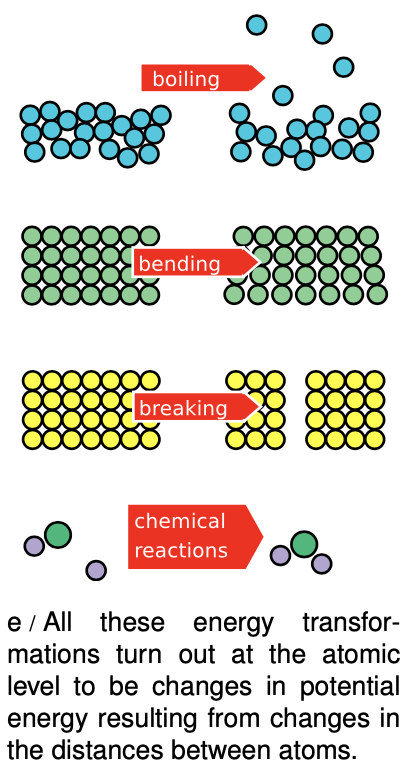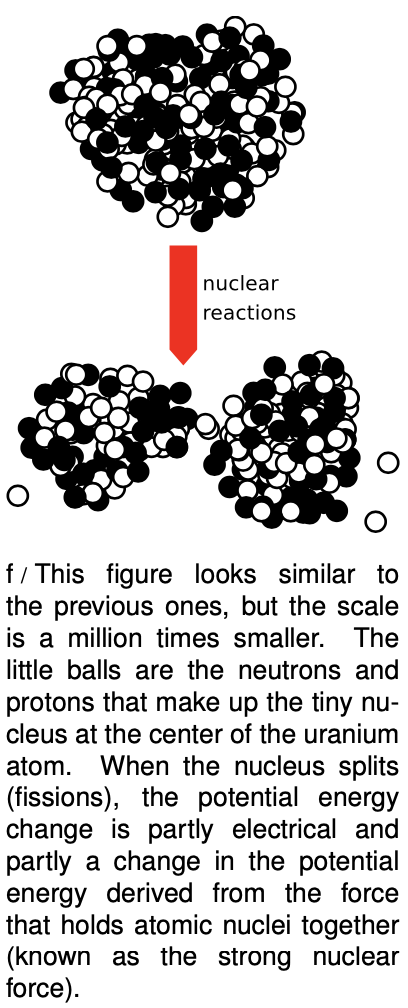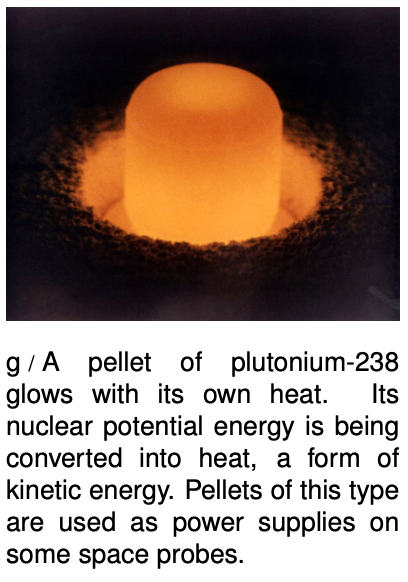LM 12.3 All energy is potential or kinetic Collection
Tags | |
UUID | 1e4927c5-f145-11e9-8682-bc764e2038f2 |
12.3 All energy is potential or kinetic by Benjamin Crowell, Light and Matter licensed under the Creative Commons Attribution-ShareAlike license.
12.3 All energy is potential or kinetic
 In the same way that we found that a change in temperature is really only a change in kinetic energy at the atomic level, we now find that every other form of energy turns out to be a form of potential energy. Boiling, for instance, means knocking some of the atoms (or molecules) out of the liquid and into the space above, where they constitute a gas. There is a net attractive force between essentially any two atoms that are next to each other, which is why matter always prefers to be packed tightly in the solid or liquid state unless we supply enough potential energy to pull it apart into a gas. This explains why water stops getting hotter when it reaches the boiling point: the power being pumped into the water by your stove begins going into potential energy rather than kinetic energy.
In the same way that we found that a change in temperature is really only a change in kinetic energy at the atomic level, we now find that every other form of energy turns out to be a form of potential energy. Boiling, for instance, means knocking some of the atoms (or molecules) out of the liquid and into the space above, where they constitute a gas. There is a net attractive force between essentially any two atoms that are next to each other, which is why matter always prefers to be packed tightly in the solid or liquid state unless we supply enough potential energy to pull it apart into a gas. This explains why water stops getting hotter when it reaches the boiling point: the power being pumped into the water by your stove begins going into potential energy rather than kinetic energy.
As shown in figure e, every stored form of energy that we encounter in everyday life turns out to be a form of potential energy at the atomic level. The forces between atoms are electrical and magnetic in nature, so these are actually electrical and magnetic potential energies.
 Although light is a topic of the second half of this course, it is useful to have a preview of how it fits in here. Light is a wave composed of oscillating electric and magnetic fields, so we can include it under the category of electrical and magnetic potential energy.
Although light is a topic of the second half of this course, it is useful to have a preview of how it fits in here. Light is a wave composed of oscillating electric and magnetic fields, so we can include it under the category of electrical and magnetic potential energy.
Even if we wish to include nuclear reactions in the picture, there still turn out to be only four fundamental types of energy:
kinetic energy (including heat)
gravitational potential energy
electrical and magnetic potential energy
nuclear potential energy

Discussion Question
A Referring back to the pictures at the beginning of the chapter, how do all these forms of energy fit into the shortened list of categories given above?
12.3 All energy is potential or kinetic by Benjamin Crowell, Light and Matter licensed under the Creative Commons Attribution-ShareAlike license.
Calculators and Collections
- Comments
- Attachments
- Stats
No comments |
